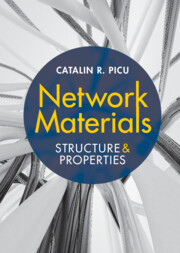Book contents
- Network Materials
- Network Materials
- Copyright page
- Contents
- Preface
- 1 Introduction
- 2 Fibers and Fiber Bundles
- 3 Fiber Interactions
- 4 Network Structure and Geometric Parameters
- 5 Affine Deformation
- 6 Mechanical Behavior and Relation to Structural Parameters
- 7 Constitutive Formulations for Network Materials
- 8 Strength and Toughness of Network Materials
- 9 Time Dependent Behavior
- 10 Networks with Fiber Surface Interactions
- 11 Composite Networks
- Index
- References
7 - Constitutive Formulations for Network Materials
Published online by Cambridge University Press: 15 September 2022
- Network Materials
- Network Materials
- Copyright page
- Contents
- Preface
- 1 Introduction
- 2 Fibers and Fiber Bundles
- 3 Fiber Interactions
- 4 Network Structure and Geometric Parameters
- 5 Affine Deformation
- 6 Mechanical Behavior and Relation to Structural Parameters
- 7 Constitutive Formulations for Network Materials
- 8 Strength and Toughness of Network Materials
- 9 Time Dependent Behavior
- 10 Networks with Fiber Surface Interactions
- 11 Composite Networks
- Index
- References
Summary
A review of current constitutive formulations for Network materials is presented in this chapter. Network materials are composed from discrete elements and are not continua. Their behavior is somewhat similar to that of mechanisms. Furthermore, deformation is generally nonaffine due to the stochastic network structure. These observations render difficult the adaptation of classical constitutive equations for this class of materials. These issues are discussed in detail in the opening section. Further, the chapter is divided into four sections, each presenting models of a certain type. The first category includes phenomenological models defined based on a free energy functional and examples relevant for thermal networks (elastomers and gels) are presented. The next three categories encompass mechanism-based models, which are divided based on the degree to which the respective models account for nonaffinity in affine, quasi-affine, and nonaffine models. An outline of the challenges and opportunities related to the development of mechanism-based constitutive models for Network materials is presented in closure.
Keywords
- Type
- Chapter
- Information
- Network MaterialsStructure and Properties, pp. 252 - 277Publisher: Cambridge University PressPrint publication year: 2022

